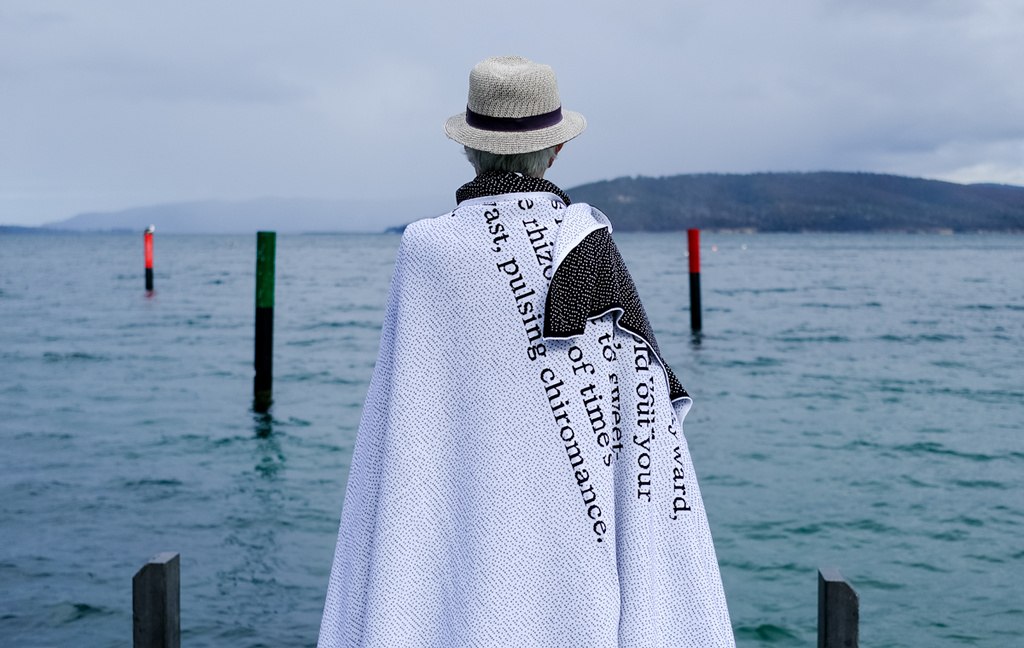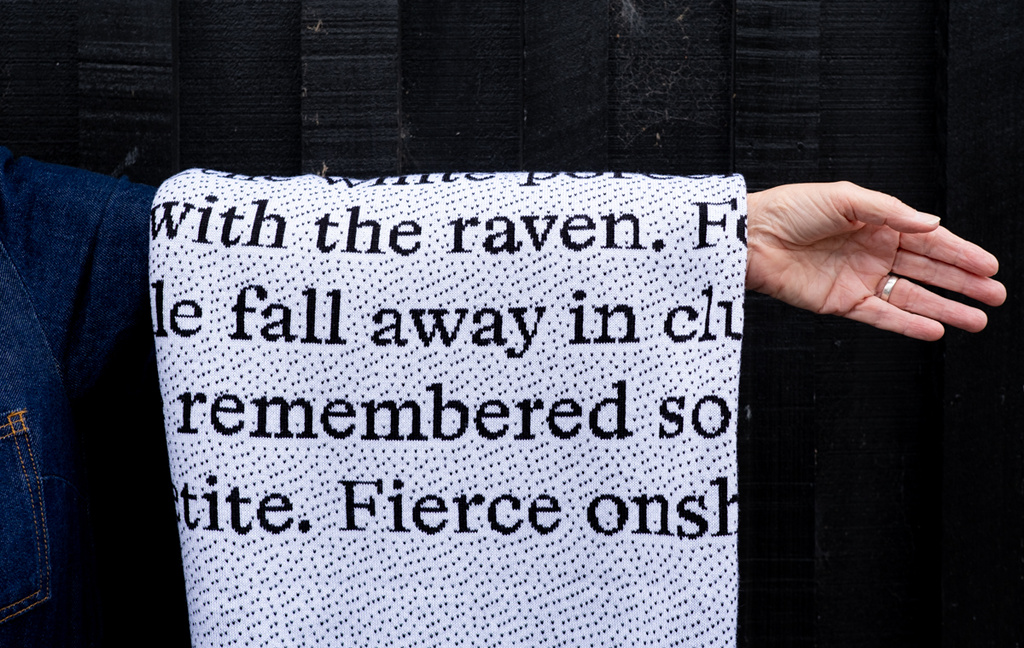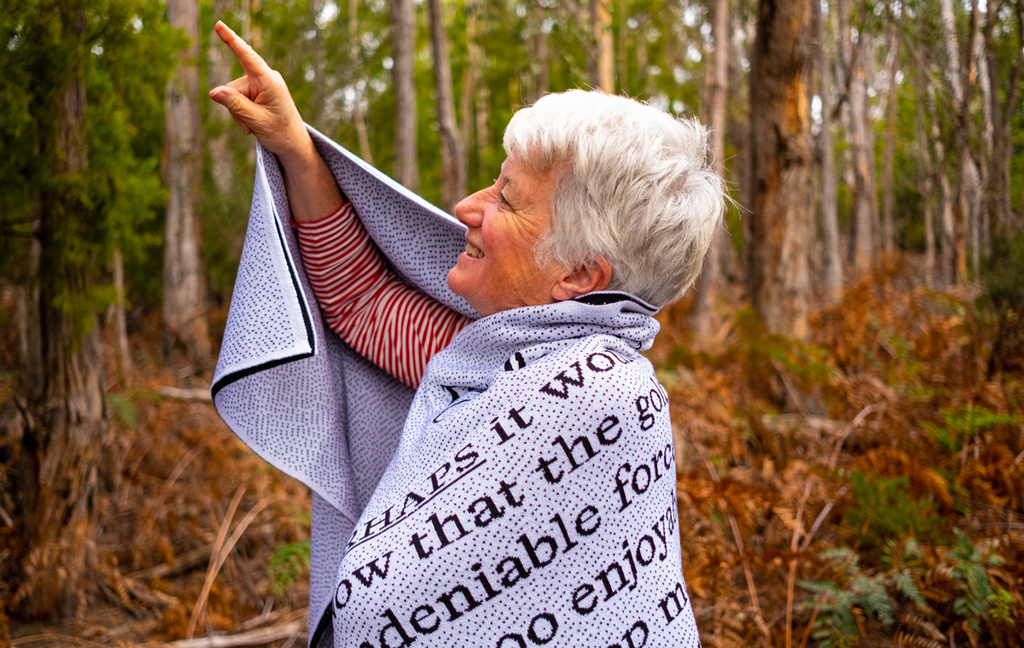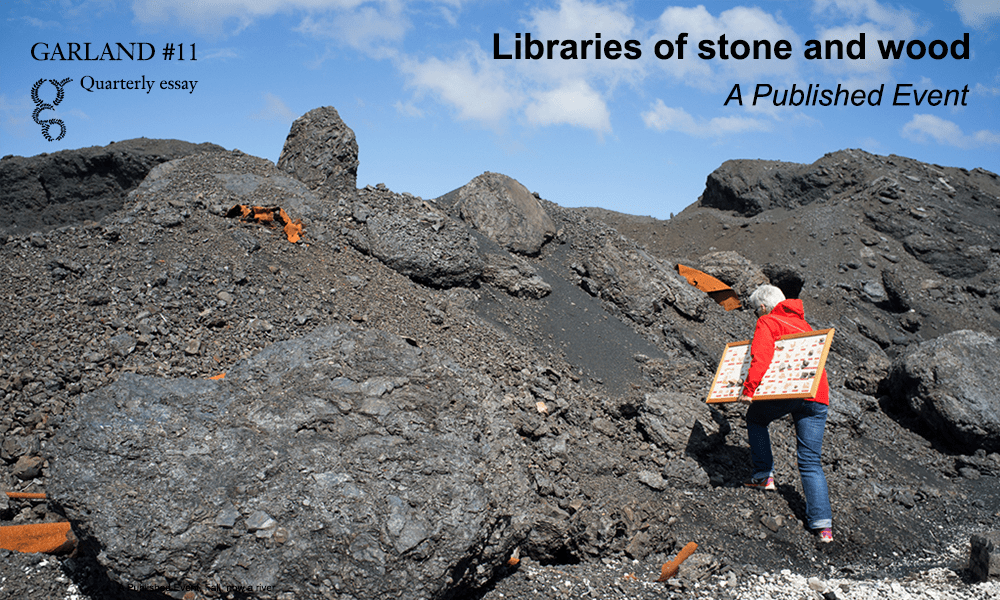
A Published Event, The Rest of Us #VII Foreword, 2024, merino wool, 185cm x 150cm, photo: Justy Phillips
In a homage to bookbinding, the pages of this book are individually knitted as blankets to be read and used by readers across the world.
The Rest of Us is a soft press fabrication from A Published Event. An episodic book knitted in skeins of extra-fine merino wool.
No cover. No dust jacket. No endpapers. We begin with a foreword and then go page by page. Iterative and episodic, The Rest of Us is a narrative book that unfolds in relations of illness and care. A soft-press chronicle of everyday life. A book of inclusions, of memory, loss, birdlife, pain, weather, grief, people, our garden and the cosmos.
For this book, we write one new page every week and publish it directly to our website each Friday. Pages are acquired by readers around the world. After purchase, each digital page is then knitted as a one-off jacquard blanket. Each page weighs one kilo and measures 185cm x 150cm in size. Enclosed in a hand-sewn calico bag, dyed using plant materials from our own garden, pages are carefully documented and then folded and posted to their readers. Each week we repeat this process. Write. Share. Knit. Dye. Sew. Exchange.

A Published Event, The Rest of Us #VII Foreword, 2024, screenshot digital file, photo: Justy Phillips
For A Published Event, book-making is often an act of making-public the hidden, the private and otherwise obscured. The Rest of Us is a book through which we surface these private moments in knitted, looped and knotted yarn. Through this work we seek to unfold a broader conversation around “thanatology”—the study of death and dying—a cycle that is always drawn from longer threads of living experience.
In this work, we raise the proposition that when the raw materials of a book include the complexity of experience itself—the work must inevitably begin with the trouble of how to make one’s narrative palatable. By this we mean publicly shareable, exchangeable; and unusually, in this case, wearable too.

A Published Event, The Rest of Us #VII Foreword, 2024, merino wool, 185cm x 150cm, photo: Justy Phillips
Composing a book made of knitted wool might seem a curious engagement, but for us, it is not such a leap from analog letterpress printing to the digital jacquard loom. Both processes share a great capacity for striking language into tactile fibre. Living in Lutruwita/Tasmania—an island celebrated for its high-quality exports of extra-fine merino woollen fleece; also makes working with wool the perfect medium for this kind of serialised book. Through its distinctive properties of elasticity and resilience, wool is an incredibly versatile material. These qualities, when afforded to publishing, allow us to rethink existing structures of book-making. We ask: How might elasticity and resilience emerge in relation to writing, knitting, reading and the wearing of an artisanal book? And can we manipulate the scale, materiality and duration of publishing to harness feelings of empathy, buoyancy and resilience in ourselves and our readers?
For thousands of years, the blanket has been an object used for warmth, refuge, fellowship and trade, but there is a darker side to these embodied artefacts too. In her recent book, titled “Blanket”, Kara Thompson unfolds a parallel history of the blanket as an object of oppression and colonial power, dispossession and erasure. We learn that in more than one act of invasion, blankets have been used as a medium of biological warfare, spreading illness and diseases such as smallpox, disproportionately through First Nations people. Imbued with legacies of exploitation and aggression, it is important for us to recognise that alongside histories of celebration and labour, the blanket-as-object cannot be decoupled from this sinister lineage. In turning page into blanket, our hope is to build new histories whilst honouring these traumas of the past.
As artists, we have thought much about the intimate complexity of telling as a mode of publishing and the ways in which telling is bound to the intimate machinations of the body. We think of the loops that brought us here (from England from archaeology from reading from memory). These circumnavigations continue to circulate now—often without warning.
Through The Rest of Us we inhabit memory as a process of recovery—a way of bringing-the-body-back-together-again. Crossing thresholds of privacy and public (and back again) has been critical to our conceptual, language-based practice for nearly two decades. We want to absorb and process complexity in order to illuminate tensions of body, transformation and resilience. By navigating our own experiences of illness and care, we focus our writing on how it feels to embody a language of intimacy and rest. Everything is possibility. Nothing is abandoned. No one left behind.
Our process of book design pays tribute to the craft of bookbinding, in particular the gathering of loose-leaf folios and printed serials. At the top of every page we place a “catchphrase”—a historical device that enables the reader to trace a flow of text from one page to the next. Put simply, the last line of the previous page becomes the header of the following. This device affords the reader a deep and active relationship with what came before and that which follows. As the pages of this unbound chronicle are slowly acquired, every page and every reader becomes intrinsically connected to the next.

A Published Event, The Rest of Us #68, #109 and #222, 2025, merino wool, 185cm x 150cm, photo: Justy Phillips. Courtesy Naomi Milgrom Foundation.
In this book, pagination designates duration. Each page number corresponds to the calendar day of the year since the first day of publication. For example, page #263, which begins with the catchphrase “How Hard It Is To Love What We Cannot See”, was published on day 263—the 20th September 2024. At the foot of each page sits the title “The Rest of Us”. A note to those of us who are rendered invisible by illness, age or productivity. Despite how alone we might feel when we are afraid and tired and in need of a rest, this single, repetitive line reminds us that we are together—in visibility, in warmth and in respite.
It is essential to us that each page is only ever knitted once. This idea is the conceptual spine of this book. Harnessing digital technology (on-demand jacquard knitting machines) to create a new kind of wearable page, our book is custom knitted on large, computerised machines at a mill in southwest Germany. Two differently coloured yarns are needed to knit each page (we have chosen black and white in reference to histories of print). “Jacquard”, also known as stranded knitting, is a term drawn from weaving in which intricate designs can be knitted directly into the fabric’s construction (rather than being embroidered, applied or printed). Similar to a printed page, there are two obvious sides to each blanket—a recto or front (white background with black text) and a verso or back (reversed white text on a black background).
The Rest of Us exists as a single book bound together by its readers. As readers take custodianship of each newly fabricated page, these editions soon become wearable objects, often held close to the body in a domestic setting. As a distributed assemblage of human bodies is now wrapped in the comfort of consecutively knitted pages, it is the embodiment of each page that becomes its bound spine. Each reading body now bears the weight of one page, enabling the weight of our writing (its trauma, grief and healing) to be held, no longer by one (or two), but shared in the arms of many. A spine of collective strength. Harmony. Desire. Writing as need. Readership as glue. Comfort everywhere. Beyond its individual pages, it is this collective holding that remains the artwork’s enduring presence in the world.
This is love is it not? This thickness. This publishing as radical care.
Afterword
We have been deeply touched by the number of readers whose pages arrived, uncannily at the perfect time. These moments of receivership, they write, are anniversaries of grief, of celebration, of remembrance. This timeliness recognises that ecologies of tenderness are now more urgent than ever. All this chronic time. All this touch. Hearing loss and heart failure. The proximity of it all. In a world in which so much life is faltering, driven by economies of mistruths and greed, we understand more than ever, how all these small things matter.
Special Note
In this story, local names are shown in palawa kani, the language of Tasmanian Aborigines.
Read with us by subscribing to our free weekly publishing of The Rest of Us. You can read all published pages and buy available pages through our website: www.therestofus.net
Further Reading
Thompson, K. Blanket. 2018. Bloomsbury Academic
Van Horn, E. Some Words for Living Locally. Online. 2007—present.
About A Published Event
A Published Event is the collaborative partnership of Justy Phillips and Margaret Woodward. Artists, writers and publishers, we make long-term relational artworks through shared acts of public telling. We work with artists and writers, materials and ideas, writing, prose, book-works and public art. We live and work on Aboriginal land, Palawa country on the island of Lutruwita/Tasmania, Australia. Visit www.therestofus.net and www.apublishedevent.net.







